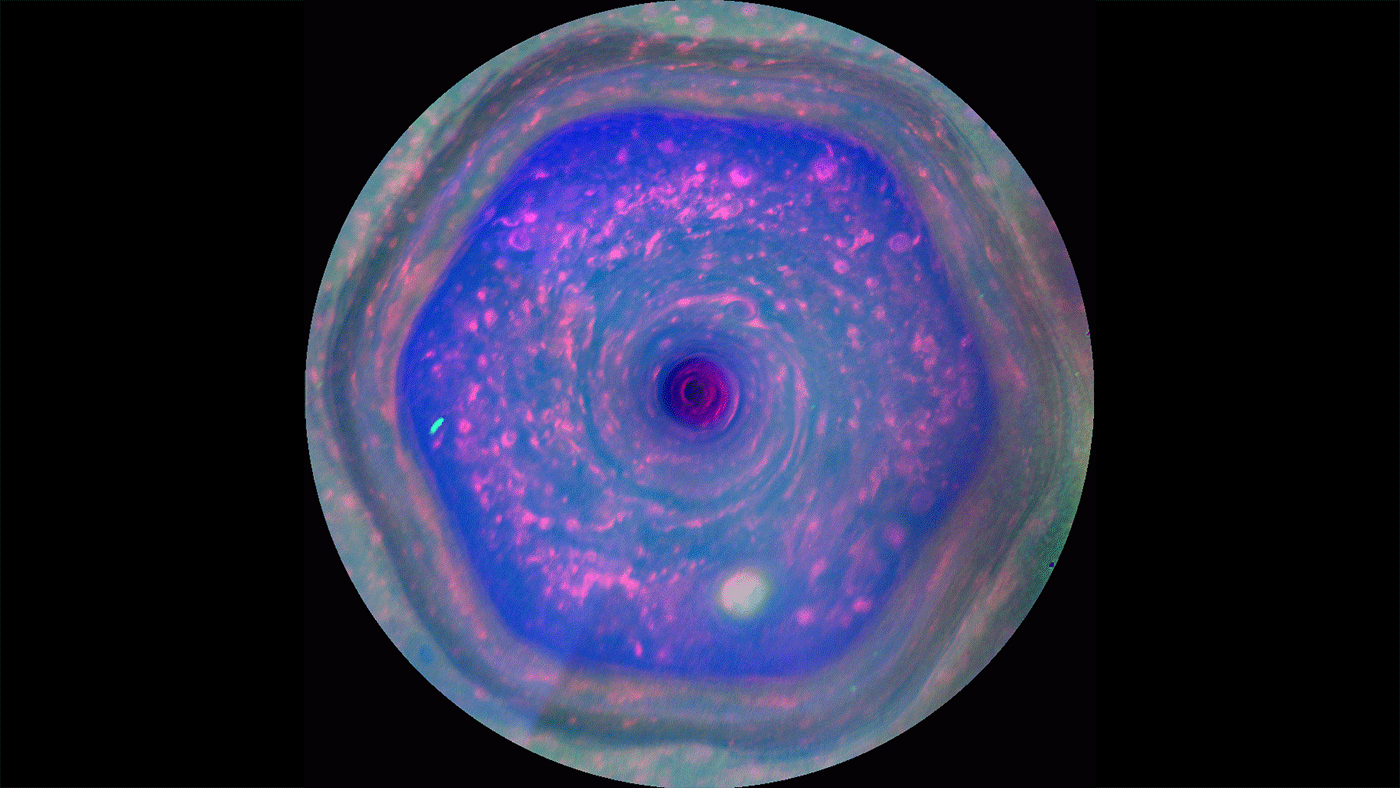Subsurface vortexes could be behind Saturn's mysterious hexagon
Saturn's bold rings are not its only signature feature.
Saturn also boasts a six-sided feature at its north pole, which scientists first noticed when NASA's Voyager 2 spacecraft visited Saturn in 1981. Saturn's hexagon is mesmerizing but also odd: the strange phenomenon only appears at the planet's north pole. In a new study, a researching duo investigated the dynamics of Saturn's churning gas to figure out what sorts of planetary fluid dynamics are creating this mystifying structure.
Last year, Rakesh Yadav and Jeremy Bloxham from the Department of Earth and Planetary Sciences at Harvard University in Cambridge, Massachusetts, performed a monthlong computer simulation to understand the physics behind Saturn's hexagon.
According to their paper, atmospheric flows within Saturn create large and small vortexes near the ringed planet's north pole. A strong horizontal jet that runs about 60 degrees latitude above the equator gets pinched and confined by these vortexes, which defines the rim of the hexagon.
Video: How does Saturn's hexagon-shaped jet stream form?
Related: The rings of Saturn are 'ringing' like a bell

One of the main points of the paper, according to Yadav, is that the vortexes do exist, but churn deep beneath the cloud tops and are therefore mostly invisible to spacecraft that have flown over Saturn like Voyager 2 and, more recently, NASA's Cassini mission. After the Voyager 2 data came back to Earth, scientists hypothesized that the hexagon could have been caused by subsurface cyclones like this new study suggests.
Although Cassini's observations of Saturn from 2004 to 2017 helped scientists learn more about the planet's fluid dynamics, the theory about subsurface vortexes didn't hold much footing when the spacecraft didn't spot prominent signs of their existence, Yadav said.
Get the Space.com Newsletter
Breaking space news, the latest updates on rocket launches, skywatching events and more!
Yadav performed model simulations of deep turbulent compressible convection, a phenomenon that happens when material at the bottom of a thick, multilayered substance of liquid or gas is hot at the bottom and cool at the top. That difference in temperature causes material to move in a circular up-down motion. Convection is pervasive throughout nature and is what creates hurricanes and tornadoes on Earth.
Yadav said the phenomenon is similar to what happens when someone puts cold water into a pot, ignites their stovetop and begins to heat up this water. The heat from the bottom of the pan stirs up the water as the water transfers heat upwards to the colder surface.

Yadav said their simulation captured the physics behind the one-pole hexagon and offered up the possibility that in the past, Saturn may have had a hexagon in the south pole and not in the north pole, or maybe a hexagon at each pole.
The simulation didn't achieve a hexagonal shape; it produced an angled object with nine sides instead of six. But the mechanics behind their simulation suggest that subsurface vortexes are behind the geometrical feature, Yadav said. "It's very possible that with different conditions we can easily get six edges instead of nine."
The computer simulations were challenging to run and researchers can only do small studies within existing parameters. This paper reported one case and Yadav hopes that researchers can run more cases in the future to better understand Saturn's beauty mark.
The paper detailing this work was published June 8 in the journal Proceedings on the National Academy of the Sciences.
- Amazing Saturn photos from NASA's Cassini orbiter
- Saturn's weird hexagon has 'sandwich-like' layers of hazy mists
- Dead Cassini spacecraft could solve mystery of Saturn's hot atmosphere
Follow Doris Elin Urrutia on Twitter @salazar_elin. Follow us on Twitter @Spacedotcom and on Facebook.
OFFER: Save 45% on 'All About Space' 'How it Works' and 'All About History'!
For a limited time, you can take out a digital subscription to any of our best-selling science magazines for just $2.38 per month, or 45% off the standard price for the first three months.
Join our Space Forums to keep talking space on the latest missions, night sky and more! And if you have a news tip, correction or comment, let us know at: community@space.com.

Doris is a science journalist and Space.com contributor. She received a B.A. in Sociology and Communications at Fordham University in New York City. Her first work was published in collaboration with London Mining Network, where her love of science writing was born. Her passion for astronomy started as a kid when she helped her sister build a model solar system in the Bronx. She got her first shot at astronomy writing as a Space.com editorial intern and continues to write about all things cosmic for the website. Doris has also written about microscopic plant life for Scientific American’s website and about whale calls for their print magazine. She has also written about ancient humans for Inverse, with stories ranging from how to recreate Pompeii’s cuisine to how to map the Polynesian expansion through genomics. She currently shares her home with two rabbits. Follow her on twitter at @salazar_elin.










